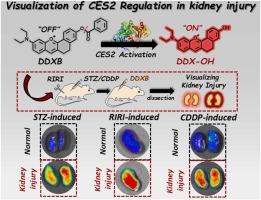酶激活荧光探针观察羧酸酯酶2在肾损伤中的调节作用
IF 8
1区 化学
Q1 CHEMISTRY, ANALYTICAL
引用次数: 0
摘要
羧酯酶2 (Carboxylesterase 2, CES2)是一种广泛表达的丝氨酸酯酶,广泛分布于各个器官和组织,在维持正常生理功能中发挥重要作用,而CES2的异常表达与许多代谢性疾病和癌症有关。因此,开发高效的检测CES2活性的工具对CES2的相关临床诊断和生理功能研究具有重要意义。迄今为止,已经开发了几种酶激活荧光探针用于CES2检测。其中,CES2在糖尿病、结肠炎、癌症和肝损伤等疾病中的调节可以可视化。然而,尽管CES2在肾脏中表现出较高的表达水平,但其在肾损伤病理过程中的调节作用却很少被研究,因此迫切需要进行相关的前期研究。本研究通过合理设计和构建对CES2具有高催化效能、敏感性和特异性的酶激活荧光探针(DDXB),成功观察了对乙酰氨基酚(APAP)诱导的肝损伤和葡聚糖硫酸钠(DSS)诱导的结肠炎模型中CES2活性下调的情况。最重要的是,通过ddxb荧光成像首次发现链脲佐菌素(STZ)、肾缺血再灌注(RIRI)和顺铂(CDDP)诱导的肾损伤模型中CES2的异常上调,并通过免疫组化(IHC)染色进一步证实。因此,首次为CES2作为潜在的肾损伤生物标志物提供了初步证据,该探针可为更多疾病的相关诊断或进一步研究CES2的生理功能提供有效工具。本文章由计算机程序翻译,如有差异,请以英文原文为准。

Visualization of carboxylesterase 2 regulation in kidney injury via an enzyme-activated fluorescent probe
Carboxylesterase 2 (CES2), an extensively expressed serine esterase which widely distributed in various organs and tissues, exerts important roles in maintaining normal physiological function while abnormal expression of CES2 was correlated with many metabolic diseases and cancers. Thus, to develop efficient tool for detection of CES2 activity is of great importance in related clinical diagnosis and research of physiological function of CES2. To date, several enzyme-activated fluorescent probes were developed for CES2 sensing. Among which regulation of CES2 in diseases such as diabetics, colitis, cancers and liver injury could be visualized. However, even though CES2 displayed relatively high expression level in kidney, its regulation in pathological process of kidney injury was rarely studied, and thus related preliminary investigation is in urgent demand. Herein, by rational design and construction of an enzyme-activated fluorescent probe (named as DDXB) with high catalytic efficacy, sensitivity and specificity toward CES2, down-regulation of CES2 activity in acetaminophen (APAP)-induced liver injury and dextran sulfate sodium (DSS)-induced colitis model was successfully visualized. Most importantly, aberrant up-regulation of CES2 in streptozotocin (STZ), renal ischemia reperfusion (IR) injury (RIRI) and cisplatin (CDDP)-induced kidney injury model was first revealed via DDXB-based fluorescence imaging and further confirmed by immunohistochemistry (IHC) staining. Thus, preliminary evidence for identifying CES2 as potential biomarker of kidney injury were first provided, and the newly developed probe could serve as an efficient tool for related diagnosis or further investigation of CES2 physiological function in more diseases.
求助全文
通过发布文献求助,成功后即可免费获取论文全文。
去求助
来源期刊

Sensors and Actuators B: Chemical
工程技术-电化学
CiteScore
14.60
自引率
11.90%
发文量
1776
审稿时长
3.2 months
期刊介绍:
Sensors & Actuators, B: Chemical is an international journal focused on the research and development of chemical transducers. It covers chemical sensors and biosensors, chemical actuators, and analytical microsystems. The journal is interdisciplinary, aiming to publish original works showcasing substantial advancements beyond the current state of the art in these fields, with practical applicability to solving meaningful analytical problems. Review articles are accepted by invitation from an Editor of the journal.
 求助内容:
求助内容: 应助结果提醒方式:
应助结果提醒方式:


